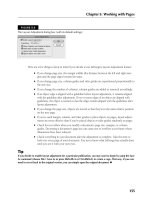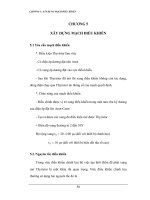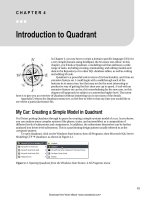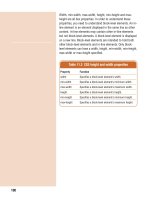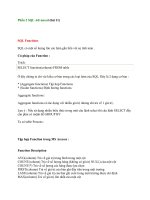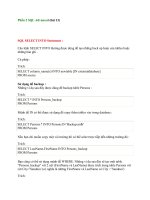Tài liệu SQL Clearly Explained- P5 ppt
Bạn đang xem bản rút gọn của tài liệu. Xem và tải ngay bản đầy đủ của tài liệu tại đây (457.78 KB, 50 trang )
200 Chapter 8: Data Modication
e result is 27 rows copied into the summary table, one for
each unique ISBN in the volume table.
Note: Should you store summary data like that placed in the table
created in the preceding example? e answer is “it depends.” If it
takes a long time to generate the summary data and you use the
data frequently, then storing it probably makes sense. But if you
can generate the summary data easily and quickly, then it is just
as easy not to store it and to create the data whenever it is needed
for output.
Placement of New Rows
Where do new rows go when you add them? at depends on
your DBMS. Typically, a DBMS maintains unique internal
identiers for each row that is not accessible to users (some-
thing akin to the combination of a row number and a table
identier) to provide information about the row’s physical
storage location. ese identiers continue to increase in value.
If you were to use the SELECT * syntax on a table, you would
see the rows in internal identier order. At the beginning of a
table’s life, this order corresponds to the order in which rows
were added to the table. New rows appear to go at the “bot-
tom” of the table, after all existing rows. As rows are deleted
from the table, there will be gaps in the sequence of row identi-
ers. However, the DBMS does not reuse them (to “ll in the
holes”) until it has used up all available identiers. If a database
is very old, very large, and/or very active, the DBMS will run
out of new identier and will then start to reuse those made
available by deleted rows. In that case, new rows may appear
anywhere in the table. Give that you can view rows in any or-
der by using the ORDER BY clause, it should make absolutely
no dierence to an end user or an application program where
a new row is added.
Please purchase PDF Split-Merge on www.verypdf.com to remove this watermark.
Updating Data 201
Although most of today’s end users modify existing data using
an on-screen form, the SQL statements to modify the data
must nonetheless be issued by the program providing the form.
For example, as someone at the rare book store adds volumes
to a sale, the volume table is updated with the selling price and
the sale ID. e selling_price is also added to the total amount
of the sale in the sale table.
e SQL UPDATE statement aects one or more rows in a
table, based on row selection criteria in a WHERE predicate.
UPDATE as the following general syntax:
UPDATE table_name
SET column1 = new_value, column2 = new_value, …
WHERE row_selection_predicate
If the WHERE predicate contains a primary key expression,
then the UPDATE will aect only one row. For example, to
change a customer’s address, the rare book store could use
UPDATE customer
SET street = ‘195 Main Street’
city = ‘New Town’
zip = ‘11111’
WHERE customer_numb = 5;
However, if the WHERE predicate identies multiple rows,
each row that meets the criteria in the predicate will be modi-
ed. To raise all $50 prices to $55, someone at the rare book
store might write a query as
UPDATE books
SET asking_price = 55
WHERE asking_price = 50;
Notice that it is possible to modify the value in a column be-
ing used to identify rows. e DBMS will select the rows to be
modied before making any changes to them.
Updating Data
Please purchase PDF Split-Merge on www.verypdf.com to remove this watermark.
202 Chapter 8: Data Modication
If you leave the WHERE clause o an UPDATE, the same
modication will be applied to every row in the table. For ex-
ample, assume that we add a column for sales tax to the sale
table. Someone at the rare book store could use the following
statement to compute the tax for every sale:
UPDATE sale
SET sales_tax = sale_total_amt * 0.075;
e expression in the SET clause takes the current value in the
sale_total_amt column, multiplies it by the tax rate, and puts
it in the sales_tax column.
Like the UPDATE statement, the DELETE statement aects
one or more rows in a table based on row selection criteria in a
WHERE predicate. e general syntax for DELETE is
DELETE FROM table_name
WHERE row_selection_predicate
For example, if a customer decided to cancel an entire pur-
chase, then someone at the rare book store would use some-
thing like
DELETE FROM sale
WHERE customer_numb = 12 AND sale_date = ’05-
Jul-2013’;
Assuming that all purchases on the same date are considered
a single sale, the WHERE predicate identies only one row.
erefore, only one row is deleted.
When the criteria in a WHERE predicate identify multiple
rows, all those matching rows are removed. If someone at the
rare book store wanted to delete all sales for a specic cus-
tomer, then the SQL would be written
DELETE FROM sale
WHERE customer_numb = 6;
Deleting Rows
Please purchase PDF Split-Merge on www.verypdf.com to remove this watermark.
Deleting Rows 203
In this case, there are multiple rows for customer number 6, all
of which will be deleted.
DELETE is a potentially dangerous operation. If you leave o
the WHERE clause—DELETE FROM sale—you will delete
every row in the table! (e table remains in the database with-
out any rows.)
e preceding examples of DELETE involve a table that has
a foreign key in another table (sale_id in volume) referenc-
ing it. It also has a foreign key of its own (customer_numb
referencing the primary key of customer). You can delete rows
containing foreign keys without any eect on the rest of the
database, but what happens when you attempt to delete rows
that do have foreign keys referencing them?
Note: e statement in the preceding paragraph refers to database
integrity issues and clearly misses the logical issue of the need to
decrement the total sale amount in the sale table whenever a vol-
ume is removed from the sale.
Assume, for example, that a customer cancels a purchase. Your
rst thought might be to delete the row for that sale from the
sale table. ere are, however, rows in the volume table that
reference that sale and if the row for the sale is removed from
sale, there will be no primary key for the rows in volume to
reference and referential integrity will be violated.
What actually happens in such a situation depends on what
was specied when the table containing the primary key being
referenced was created. ere are four options for handling the
deletion of primary key rows that have foreign key rows that
reference them:
◊ SET NULL: e values of all foreign keys that reference
the deleted primary key row are set to null. is is the
option we want for our particular example. However,
Deletes and
Referential
Integrity
Please purchase PDF Split-Merge on www.verypdf.com to remove this watermark.
204 Chapter 8: Data Modication
nulls cannot be used when the foreign key is part of the
primary key of its own table.
◊ SET DEFAULT: e values of all foreign keys that ref-
erence the deleted primary key row are set to a default
value. is would not be a reasonable solution for our
example because we don’t want to set a generic sale ID.
◊ CASCADE: When the primary key row is deleted, all
foreign key rows that reference it are deleted as well.
is is something we denitely don’t want to do in our
example. Volumes need to stay in the database, sold or
unsold.
◊ NO ACTION: Disallow the deletion of a primary key
row if there are foreign key rows that reference it. is
alternative makes sense for the customer table because
we do not want to delete any customers who have pur-
chases in the sale table. By the same token, we would
probably use this option for the book table so that we
do not delete data about books that we may be likely to
purchase for the store.
e SQL:2003 standard introduced a very powerful and ex-
ible way to insert, update, or delete data using the MERGE
statement. MERGE includes a condition to be tested and al-
ternative sets of actions that are performed when the condition
is or is not met. e model behind this statement is the merg-
ing of a table of transactions into a master table.
MERGE has the following general syntax:
MERGE INTO target_table_name USING source_ta-
ble_name ON merge_condition
WHEN MATCHED THEN
update/delete_specification
WHEN NOT MATCHED THEN
insert specification
MERGE
Please purchase PDF Split-Merge on www.verypdf.com to remove this watermark.
Deleting All Rows: TRUNCATE TABLE 205
Deleting All Rows: TRUNCATE
TABLE
e 2008 SQL standard introduces a new command—
TRUNCATE TABLE—that removes all rows from a table
more quickly than a DELETE without a WHERE clause. e
command’s general syntax is
TRUNCATE TABLE table_name
Like the DELETE without a WHERE clause, the table struc-
ture remains intact and in the data dictionary.
ere are some limits to using the command:
◊ It cannot be used on a table that has foreign keys refer-
encing it.
◊ It cannot be used on a table on which indexed views are
based.
◊ It cannot activate a trigger.
Although DELETE and TRUNCATE TABLE seem to have
the same eect, they do work dierently. DELETE removes
the rows one at a time and writes an entry into the database log
le for each row. In contrast, TRUNCATE TABLE deallocates
space in the database les, making the space formerly occupied
by the truncated table’s rows available for other use.
Note: Some DBMSs call MERGE functionality UPSERT.
Notice that when the merge condition is matched (in other
words, evaluates as true for a given row) an update and/or de-
lete is performed. When the condition is not matched, an insert
Please purchase PDF Split-Merge on www.verypdf.com to remove this watermark.
206 Chapter 8: Data Modication
is performed. Either the MATCHED or NOT MATCHED
clause is optional.
e target table is the table that will be aected by the chang-
es made by the statement. e source table—which can be a
base table or a virtual table generated by a SELECT—provides
the source of the table. To help you understand how MERGE
works, let’s use the classic model of applying transactions to a
master table. First, we need a transaction table:
transactions (sale id, inventory id,
selling_price, sale_date, customer_numb)
e transactions table contains information about the sale of
a single volume. (It really doesn’t contain all the necessary rows
for the sale table, but it will do for this example.) If a row for
the sale exists in the sale table, then the selling price of the vol-
ume should be added to existing sale total. However, if the sale
is not in the sale table, then a new row should be created and
the sale total set to the selling price of the volume. A MERGE
statement that will do the trick might be written as
MERGE INTO sale S USING transactions T
ON (S.sale_id = T.sale_id)
WHEN MATCHED THEN
UPDATE SET sale_total_amt =
sale_total_amt + selling_price
WHEN NOT MATCHED
INSERT (sale_id, customer_numb,
sale_date, sale_total_amt)
VALUES (T.sale_id, T.customer_numb,
T.sale_date, T.selling_price);
e target table is sale; the source table is transactions. e
merge condition looks for a match between sale IDs. If a
match is found, then the UPDATE portion of the command
performs the modication of the sale_total_amt column. If
no match is found, then the insert occurs. Notice that the IN-
SERT portion of the command does not need a table name
Please purchase PDF Split-Merge on www.verypdf.com to remove this watermark.
Deleting All Rows: TRUNCATE TABLE 207
because the table aected by the INSERT has already been
specied as the target table.
As we said earlier, the source table for a merge operation doesn’t
need to be a base table; it can be a virtual table created on the
y using a SELECT. For example, assume that someone at the
rare book store needs to keep a table of total purchases made
by each customer. e following table can be used to hold
that data:
summary_stats (customer numb, year,
total_purchases)
You can nd the MERGE statement below. e statement as-
sembles the summary data using a SELECT that extracts the
year from the sale date and sums the sale amounts. en, if a
summary row for a year already exists in summary_stats, the
MERGE adds the amount from the source table to what is
stored already in the target table. Otherwise, it adds a row to
the target table.
MERGE INTO summary_stats AS S USING
(SELECT customer_numb,
EXTRACT (YEAR FROM sale_date) AS Y,
SUM (sale_total_amt AS M) AS T
FROM sale
GROUP BY customer_numb, Y)
ON (CAST(S.customer_numb AS CHAR (4)) ||
CAST (S.year AS CHAR(4)) =
CAST(T.customer_numb AS CHAR (4)) ||
CAST (T.year AS CHAR(4)))
WHEN MATCHED
UPDATE SET total_purchases = T.M
WHEN NOT MATCHED
INSERT VALUES (customer_numb, Y, M);
As powerful as MERGE seems to be, the restriction of UP-
DATE/DELETE to the matched condition and INSERT to
the unmatched prevents it from being able to handle some
situations. For example, if someone at the rare book store
Please purchase PDF Split-Merge on www.verypdf.com to remove this watermark.
208 Chapter 8: Data Modication
wanted to archive all orders more than two years old, the pro-
cess would involve creating a row for each sale that didn’t ex-
ist in the archive table and then deleting the row from the
sale table. (We’re assuming that the delete cascades, removing
all rows from volume as well.) e problem is that the delete
needs to occur on the unmatched condition, which isn’t al-
lowed with the MERGE syntax.
Please purchase PDF Split-Merge on www.verypdf.com to remove this watermark.
9
211
As a complete data manipulation language, SQL contains
statements that let you create, modify, and delete structural
elements in a database. In this chapter we will begin the discus-
sion of a database’s structural elements by looking at schemas
and the permanent base tables that you create within them.
is discussion will be concluded in Chapter 10, which covers
additional structural elements such as views, temporary tables,
and indexes.
e actual le structure of a database is implementation de-
pendent, as is the procedure needed to create database les.
erefore, the discussion in this chapter assumes that the nec-
essary database les are already in place.
e objects in a database maintained using SQL are arranged
in a hierarchy diagrammed in Figure 9-1.
1
e smallest units
with which a database works—the columns and rows—appear
in the center. ese in turn are grouped into tables and views.
e tables and views that constitute a single logical database
are collected into a schema. Multiple schemas are grouped into
catalogs, which can then be grouped into clusters. A catalog
1 Some DBMSs support a “create database” capabiity, which provides
an overall named unit for all the elements in a database. However, a “data-
base” isn’t a structural element in the SQL standard.
Schemas and Tables
Database
Object
Hierarchy
©2010 Elsevier Inc. All rights reserved.
10.1016/B978-0-12-375697-8.50009-1
Please purchase PDF Split-Merge on www.verypdf.com to remove this watermark.
212 Chapter 9: Schemas and Tables
usually contains information describing all the schemas handled
by one DBMS. Catalog creation is implementation dependent
and therefore not part of the SQL standard.
Prior to SQL-92, clusters often represented database les, and the
clustering of objects into les was a way to increase database per-
formance. e current concept of a cluster, however, is a group
of catalogs that are accessible using the same connection to a da-
tabase server. None of the groupings of database objects in the
SQL standard are related to physical storage structures. If you
are working with a centralized mainframe DBMS, you may nd
multiple catalogs stored in the same database le. However, on
smaller or distributed systems, you are just as likely to nd one
S
c
h
e
m
a
s
T
a
b
l
e
s
a
n
d
V
i
e
w
s
Columns
and rows
Figure 9-1: The SQL database object hierarchy
Please purchase PDF Split-Merge on www.verypdf.com to remove this watermark.
Database Object Hierarchy 213
catalog or schema per database le or to nd a catalog or sche-
ma split between multiple les.
Clusters, catalogs, and schemas are not required elements of
a database environment. In a small installation where there is
one collection of tables serving a single purpose, for example,
it may not even be necessary to create a schema to hold them.
e way in which you name and identify database objects is in
some measure dictated by the object hierarchy:
◊ Column names must be unique within the table.
◊ Table names must be unique within the schema.
◊ Schema names must be unique within their catalog.
◊ Catalog names must be unique within their cluster.
As you saw when you were reading about data retrieval, when
a column name appears in more than one table in a query, you
must specify the table from which a column should be taken
(even if it makes no dierence which table is used). e gen-
eral form for specifying duplicate names is
table_name.column_name
If an installation has more than one schema, then you must
also indicate the schema in which a table resides:
schema_name.table_name.column_name
is naming convention means that two dierent schemas can
include tables with the same name.
By the same token, if an installation has multiple catalogs, you
will need to indicate the catalog from which an object comes
catalog_name.schema_name.table_name.column_name
Naming and
Identifying Objects
Please purchase PDF Split-Merge on www.verypdf.com to remove this watermark.
214 Chapter 9: Schemas and Tables
Note: e SQL standard refers to element names that use the dot
notation as “identier chains.”
e names that you assign to database elements can include
the following:
◊ Letters
◊ Numbers
◊ Underscores (_)
Names can be up to 128 characters long. ey are not case sen-
sitive. (In fact, many SQL command processors convert names
to all upper- or lowercase characters before submitting a SQL
statement to a DBMS for processing.)
Note: Some DBMSs also allow pound signs (#) and dollar signs
($) in element names, but neither is recognized by SQL queries so
their use should be avoided.
To a database designer, a schema represents the overall, logi-
cal design of a complete database. As far as SQL is concerned,
however, a schema is nothing more than a container for tables,
views, and other structural elements. It is up to the database
designer to place a meaningful group of elements within each
schema.
A schema is not required to create tables and views. In fact,
if you are installing a database for an environment in which
there is likely to be only one logical database, then you can just
as easily do without one. However, if more than one database
will be sharing the same DBMS and the same server, organiz-
ing database elements into schemas can greatly simplify the
maintenance of the individual databases.
To create a schema, you use the CREATE SCHEMA state-
ment. In its simplest form, it has the syntax
Schemas
Please purchase PDF Split-Merge on www.verypdf.com to remove this watermark.
Schemas 215
CREATE SCHEMA schema_name
as in
CREATE SCHEMA rare_books;
By default, a schema belongs to the user who created it (the
user ID under which the schema was created). e owner of
the schema is the only user ID that can modify the schema un-
less the owner grants that ability to other users.
To assign a dierent owner to a schema, you add an AUTHO-
RIZATION clause
CREATE SCHEMA schema_name AUTHORIZATION owner_
user_ID
For example, to assign the rare book store schema to the user
ID DBA, someone could use
CREATE SCHEMA rare_books AUTHORIZATION dba;
When creating a schema, you can also create additional da-
tabase elements at the same time. To do so, you use braces to
group the CREATE statements for the other elements, as in
CREATE SCHEMA schema_name AUTHORIZATION owner_
user_ID
{
other CREATE statements go here
}
is automatically assigns the elements within the braces to
the schema.
One of the nicest things about a relational database is that
you can add or delete database structure elements at any time.
ere must therefore be a way to specify a current schema for
Creating a Schema
Identifying the
Schema You Want
to Use
Please purchase PDF Split-Merge on www.verypdf.com to remove this watermark.
216 Chapter 9: Schemas and Tables
new database elements after the schema has been created ini-
tially with the CREATE SCHEMA statement.
SET SCHEMA schema_name
To use SET SCHEMA, the user ID under which you are
working must have authorization to work with that schema.
Alternatively, you can qualify the name of a database element
with the name of the schema. For example, if you are creating
a table, then you would use something like:
CREATE TABLE schema_name.table_name
For DBMSs that do not support SET SCHEMA, this is the
only way to attach new database elements to a schema after the
schema has been created.
A domain is an expression of the permitted values for a column
in a relation. When you dene a table, you assign each column
a data type (for example, character or integer) that provides a
broad domain. A DBMS will not store data that violate that
constraint.
e SQL-92 standard introduced the concept of user-dened
domains, which can be viewed as user-dened data types that
can be applied to columns in tables. (is means that you have
to create a domain before you can assign it to a column!)
Domains can be created as part of a CREATE SCHEMA state-
ment or, if your DBMS supports SET SCHEMA, at any time
after a schema has been dened.
To create a domain, you use the CREATE DOMAIN state-
ment, which has the following general syntax:
CREATE DOMAIN domain_name data_type
CHECK constraint_name
(expression_to_validate_values)
Domains
Please purchase PDF Split-Merge on www.verypdf.com to remove this watermark.
Schemas 217
e CHECK clause is actually a generic way to express a con-
dition that data must meet. It can include a SELECT to vali-
date data against other data stored in the database or it can
include a logical expression. In that expression, the keyword
VALUE represents the data being checked. Naming the con-
straint is optional, but doing so makes it possible to access the
constraint if you want to remove it at some time in the future.
For example, if the rare book store database should validate the
price of a book, someone might create the following domain:
CREATE DOMAIN price NUMERIC (7,2)
CHECK price_check (VALUE >= 15);
After creating this domain, a column in a table can be given
the data type of PRICE. e DBMS will then check to be
certain that the value in that column is always greater than or
equal to 15. (We will leave a discussion of the data type used
in the preceding SQL statement until we cover creating tables
in the next section of this chapter.)
e domain mechanism is very exible. Assume, for example,
that you want to ensure that telephone numbers are always
stored in the format XXX-XXX-XXXX. A domain to validate
that format might be created as
CREATE DOMAIN telephone CHAR (12)
CHECK phone_format
(SUBSTRING FROM 4 FOR 1 = ‘-‘) AND
SUBSTRING (VALUE FROM 8 FOR 1 = ‘ ‘);
You can also use the CREATE DOMAIN statement to give a
column a default value. For example, the following statement
sets up a domain that holds either Y or N and defaults to Y.
CREATE DOMAIN char_boolean CHAR (1)
DEFAULT ‘Y’
CHECK (UPPER(VALUE) = ‘Y’
OR UPPER(VALUE) = ‘N’);
Please purchase PDF Split-Merge on www.verypdf.com to remove this watermark.
218 Chapter 9: Schemas and Tables
e most important structure within a relational database is
the table. Tables contain just about everything, including busi-
ness data and the data dictionary.
SQL divides its tables into three categories:
◊ Permanent base tables: Permanent base tables are tables
whose contents are stored in the database and remain
permanently in the database unless they are explicitly
deleted.
◊ Global temporary base tables: Global temporary base
tables are tables used for working storage that are
destroyed at the end of a SQL session. e denitions
of the tables are stored in the data dictionary, but their
data are not. e tables must be loaded with data each
time they are going to be used. Global temporary
tables can be used only by the current user, but they are
visible to an entire SQL session (either an application
program or a user working with an interactive facility.)
◊ Local temporary base tables: Local temporary base
tables are similar to global temporary tables. However,
they are visible only to the specic program module in
which they are created.
Note: Temporary base tables are subtly dierent from views, which
assemble their data by executing a SQL query. You will read more
about this dierence and how temporary tables are created and
used in Chapter 10.
Most of the tables you will use will be permanent base tables.
You create them with the CREATE TABLE statement:
CREATE TABLE table_name
(column1_name column1_data_type,
column1_constraints,
column2_name column2_data_type,
column2_constraints, …
table_constraints)
Tables
Please purchase PDF Split-Merge on www.verypdf.com to remove this watermark.
Tables 219
e constraints on a table include declarations of primary and
foreign keys. e constraints on a column include whether
values in are mandatory as well as other constraints you may
decide to include in a CHECK clause.
Each column in a table must be given a data type. Although
data types are somewhat implementation dependent, you can
expect to nd most of the following:
◊ INTEGER (abbreviated INT): A positive or negative
whole number. e number of bits occupied by the
value is implementation dependent. On today’s desk-
top computers, an integer is either 32 or 64 bits. Large
computers may use up to 128 bits for integers.
◊ SMALLINT: A positive or negative whole number.
A small integer is usually half the size of a standard
integer. Using small integers when you know you will
need to store only small values can save space in the
database.
◊ NUMERIC (or occasionally, NUMBER): A xed-
point positive or negative number. A numeric value
has a whole number portion and a fractional portion.
When you create it, you must specify the total length
of the number (including the decimal point) and how
many of those digits will be to the right of the decimal
point (its precision). For example,
NUMERIC (6,2)
creates a number in the format XXX.XX. The DBMS
will store exactly two digits to the right of the deci-
mal point.
◊ DECIMAL: A xed-point positive or negative num-
ber. A decimal is similar to a numeric value. However,
the DBMS may store more digits to the right of the
Column Data Types
Please purchase PDF Split-Merge on www.verypdf.com to remove this watermark.
220 Chapter 9: Schemas and Tables
decimal than you specify. Although there is no guaran-
tee that you will get the extra precision, its presence can
provide more accurate results in computations.
◊ REAL: A “single precision” oating point value. A
oating point number is expressed in the format
±X.XXXXX * 10
YY
where YY is the power to which 10 is raised. Be-
cause of the way in which computers store oating
point numbers, a real number will never be an ex-
act representation of a value, but only a close ap-
proximation. The range of values that can be stored
is implementation dependent, although a common
range is ±10
38
. You therefore cannot specify a size
for a real number column.
◊ DOUBLE PRECISION (abbreviated DOUBLE): A
“double precision” oating point number. e range
and precision of double precision values are implemen-
tation dependent, but generally will be greater than
with single precision real numbers. For example, if the
single precision range is ±10
38
, then a typical double
precision range is ±10
308
.
◊ FLOAT: A oating point number for which you can
specify the precision. e DBMS will maintain at least
the precision that you specify. (It may be more.)
◊ BOOLEAN: A logical value that can take only the
values true and false.
◊ BIT: Storage for a xed number of individual bits. You
must indicate the number of bits, as in
BIT (n)
where n is the number of bits. (If you do not include
Please purchase PDF Split-Merge on www.verypdf.com to remove this watermark.
Tables 221
the number of bits, you will have room for only one
bit.)
◊ DATE: A date.
◊ TIME: A time.
◊ TIMESTAMP: e combination of a date and a time.
◊ CHARACTER (abbreviated CHAR): A xed-length
space to hold a string of characters. When declaring a
CHAR column, you need to indicate the width of the
column:
CHAR (n)
where n is the amount of space that will be allocated
for the column in every row. Even if you store less
than n characters, the column will always take up n
bytes and the column will be padded with blanks to
ll up empty space. The maximum number of char-
acters allowed is implementation dependent.
◊ CHARACTER VARYING (abbreviated VARCHAR):
A variable length space to hold a string of characters.
You must indicate the maximum width of the col-
umn—
VARCHAR (n)
—but the DBMS stores only as many characters as
you insert, up to the maximum n. The overall maxi-
mum number of characters allowed is implementa-
tion dependent.
◊ INTERVAL: A date or time interval. An interval data
type is followed by a qualier that species the unit of
Please purchase PDF Split-Merge on www.verypdf.com to remove this watermark.
222 Chapter 9: Schemas and Tables
the interval and optionally the number of digits. For
example,
INTERVAL YEAR
INTERVAL YEAR (n)
INTERVAL MONTH
INTERVAL MONTH (n)
INTERVAL YEAR TO MONTH
INTERVAL YEAR (n) TO MONTH
INTERVAL DAY
INTERVAL DAY (n)
INTERVAL DAY TO HOUR
INTERVAL DAY (n) TO HOUR
INTERVAL DAY TO MINUTE
INTERVAL DAY (n) TO MINUTE
INTERVAL MINUTE
INTERVAL MINUTE (n)
In the preceding examples, n species the number of
digits. When the interval covers more than one date/
time unit, such as YEAR TO MONTH, you can spec-
ify a size for only the rst unit. Year/month intervals
can include years, months, or both. Time intervals
can include days, hours, minutes, and/or seconds.
◊ BLOB (Binary Large Object): Although not univer-
sal, the BLOB data type is supported by many cur-
rent DBMSs. It can be used to store elements such
as graphics. Unlike other data types, however, BLOB
columns cannot be searched because the contents are
an undierentiated group of binary data.
In Figure 9-2 you will nd the bare bones CREATE TABLE
statements for the rare book store database. ese statements
include only column names and data types. SQL will create
tables from statements in this format, but because the tables
have no primary keys, some DBMSs will not let you enter
data.
Please purchase PDF Split-Merge on www.verypdf.com to remove this watermark.
Tables 223
As you are dening columns, you can designate a default value
for individual columns. To indicate a default value, you add a
DEFAULT keyword to the column denition, followed by the
default value. For example, in the sale relation, it makes sense
to assign the current date to the sale_date column as a default.
e column declaration is therefore written
sale_date DATE DEFAULT CURRENT_DATE
Notice that this particular declaration is using the SQL value
CURRENT_DATE. However, you can place any value after
DEFAULT that is a valid instance of the column’s domain.
e values in primary key columns must be unique and not
null. In addition, there may be columns for which you want to
require a value. You can specify such columns by adding NOT
NULL after the column declaration. Since the sta of the rare
book store wants to ensure that an order date is always entered,
the complete declaration for the column in the sale table is
sale_date DATE NOT NULL DEFAULT CURRENT_DATE
To specify a table’s primary key, you add a PRIMARY KEY
clause to a CREATE TABLE statement. e keywords PRI-
MARY KEY are followed by the names of the primary key
column or columns, surrounded by parentheses. In the case of
a concatenated primary key, place all columns that are part of
the primary key within the parentheses.
In Figure 9-3 you will nd the CREATE TABLE state-
ments for the rare book store database including primary key
declarations.
As you know, a foreign key is a column (or concatenation of
columns) that is exactly the same as the primary key of another
table. When a foreign key value matches a primary key value,
we know that there is a logical relationship between the data-
base objects represented by the matching rows.
Default Values
NOT NULL
Constraints
Primary Keys
Foreign Keys
Please purchase PDF Split-Merge on www.verypdf.com to remove this watermark.
224 Chapter 9: Schemas and Tables
CREATE TABLE publisher
(
publisher_id int,
publisher_name char (50),
);
CREATE TABLE sale
(
sale_id int,
customer_numb int,
sale_date date,
sale_total_amt decimal (8,2),
credit_card_numb char (20),
exp_month int,
exp_year int,
);
CREATE TABLE customer
(
customer_numb int,
rst_name varchar (30),
last_name varchar (30),
street varchar (50),
city varchar (30),
state_province char (2),
zip_postcode char (10),
contact_phone char (12),
);
CREATE TABLE condition_codes
(
condition_code int,
condition_description varchar (128),
);
Figure 9-2: Initial CREATE TABLE statements for the rare book store
database (continued on next page)
One of the major constraints on a relation is referential integ-
rity, which states that every nonnull foreign key must refer-
ence an existing primary key value. Early implementations of
SQL and early versions of the SQL standard did not include
support for foreign keys. Validation of referential integrity was
Please purchase PDF Split-Merge on www.verypdf.com to remove this watermark.
Tables 225
CREATE TABLE volume
(
inventory_id int,
isbn char (17),
condition_code int,
date_acquired date,
asking_price decimal (7,2),
selling_price decimal (7,2),
sale_id int,
);
CREATE TABLE work
(
work_numb int,
author_numb int,
title char (50),
);
CREATE TABLE author
(
author_numb int,
author_last_rst char (128),
);
CREATE TABLE book
(
isbn char (17),
work_numb int,
publisher_id int,
edition int,
binding char (20),
copyright_year char (4),
);
Figure 9-2 (continued): Initial CREATE TABLE statements for the
rare book store database
left up to application programmers. However, it is far better to
have foreign keys identied in the data dictionary and referen-
tial integrity enforced directly by a DBMS. Referential integ-
rity was therefore added to the SQL-89 standard.
Please purchase PDF Split-Merge on www.verypdf.com to remove this watermark.
226 Chapter 9: Schemas and Tables
Listing Table Structure
Although not part of the SQL standard, many DBMSs support a DESCRIBE command that
displays the structure of a table. (e standard SQL DESCRIBE returns information about a
prepared embedded SQL statement.) To use it, follow the keyword DESCRIBE with the name
of the table, as in
DESCRIBE customer
e result is a table showing the structure of the named table in a format similar to the following:
Table “enterprisedb.customer”
Column | Type | Modifiers
+ +
customer_numb | integer | not null
first_name | character varying(30) |
last_name | character varying(30) |
street | character varying(50) |
city | character varying(30) |
state_province | character(2) |
zip_postcode | character(10) |
contact_phone | character(12) |
Indexes:
“pk_customer” PRIMARY KEY, btree (customer_numb)
To specify a foreign key for a table, you add a FOREIGN KEY
clause:
FOREIGN KEY foreign_key_name (foreign_key_col-
umns)
REFERENCES primary_key_table (primary_key_col-
umns)
ON UPDATE update_action
ON DELETE delete_action
e names of the foreign key columns follow the keywords
FOREIGN KEY. e REFERENCES clause contains the
name of the primary key table being referenced. If the primary
key columns are named in the PRIMARY KEY clause of their
Please purchase PDF Split-Merge on www.verypdf.com to remove this watermark.

